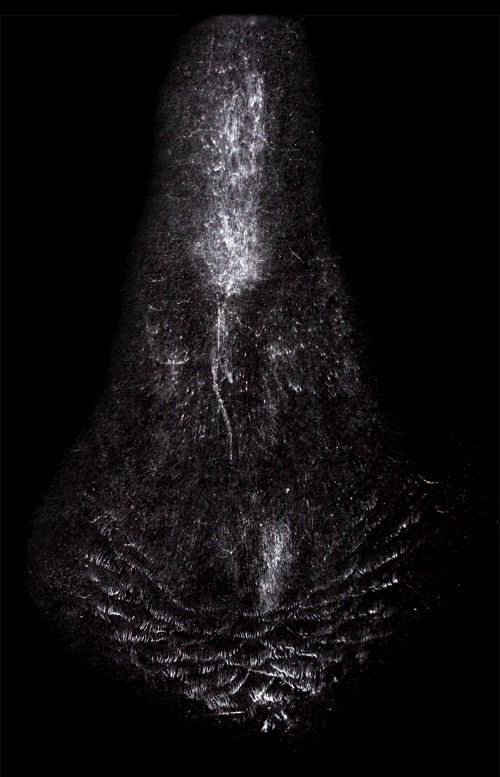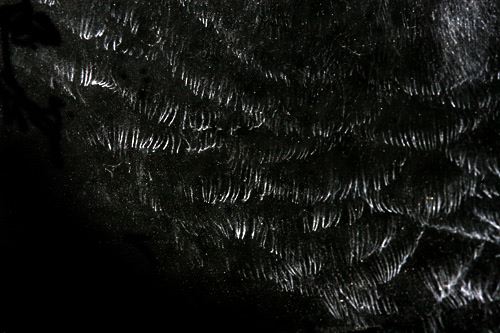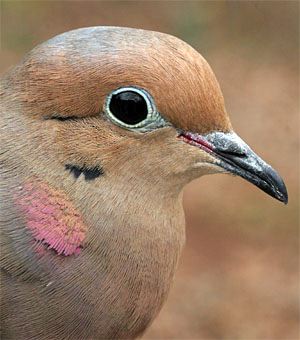|
|
|||
|
(Back to Preceding Week; on to Next Week) |
|
WINDOW STRIKE:
A STUDY IN BLACK AND WHITE One morning this week while we worked at our desk in the old farmhouse at Hilton Pond Center, a loud, dull thud caught our attention. It sounded as if a good-sized bird had flown into one of the large office windows that overlooks the pond itself--something that occasionally happens, especially when a Sharp-shinned Hawk takes aim at our backyard feeders. We immediately went out onto the deck to look for a stunned bird but found none--not even a loose feather--which meant any avian perpetrator of the sound likely survived, albeit with a bit of a headache. We didn't think much more about the incident until next day when we were back out on the deck looking in. Right in front of us on the window glass was the perfect, ghostly silhouette of a bird with outstretched wings (below). We concluded this must be the image of the bird that hit our window the day before.
All text & photos © Hilton Pond Center The outline was barely visible in bright sunshine, but when we stood at just the right angle and placed black paper behind the glass there was no mistaking this eerie image was made by a bird in full flight. We suspected the artifact was formed by "powder down" or by feather dander--white matter stuck to the glass by oil the bird uses to waterproof and condition its feathers when preening. Hard to see, the image was even more difficult to catch through the camera lens, but we gave it a try and came up with three photos. The impression left by the bird was stunning. In it we could see how the tips of the wings curved gracefully upward, with the lead edge of the front-most primary feather making the heaviest mark. Following the wing curve toward the body, we also saw a shorter bright line formed by the bird's wrist bone and hand against the window pane. Just above that was a short curved line pointing up at a 45-degree angle; this was the edge of the alular feather. The bright spots closest to the body looked a little like headlights and must have been made by the big joint where the humerus meets the ulna/radius.
While the image as a whole was graceful and ghost-like, a close-up of the body section (above) was surrealistic; it reminded us of the famous Shroud of Turin. The bottom half clearly showed imprints of the edges of breast feathers, and a large bright spot just above them was caused by impact from the bird's keel, its breastbone. The top half seems to show the bird hit the window with its bill straight ahead, the impact forcing the head to turn straight downward and roll against the glass--leaving a wide, smeared streak. We could see the outline of the bill itself at the bottom of the smear, and darker areas to either side that were likely the area around the eyes. The long, thin, crooked line that seems to arise near the tip of the bill was confusing, but may be from saliva ejected when the bird hit the glass. (We doubt it was the bird's tongue.)
We were absolutely fascinated by this spooky souvenir and zoomed in even closer on the section formed by breast feathers (above). In macro view this part of the image becomes a white-on-black abstract--short, curved lines that form larger, graceful, overlying arcs that any modernist painter or scratchboardist should be proud to claim. The more we look at this nearly three-dimensional image, the more we see; stare at it a while and it becomes nearly hypnotic. If we tear our gaze away from the artsy image and become more scientific, our next task is to identify the bird that left its calling card on the window. It must have been fairly large, since the silhouette measured 4 inches top to bottom and 16 inches from wingtip to wingtip. The good part about this whole scenario is the dove apparently survived, at least in the short term; the bad part is every bird that hits a picture window or patio door or tall building isn't so lucky. Window strikes are a real and significant danger to birds, especially those that are migrating through and unfamiliar with local hazards. But that's a story for some other time. For now we're still marveling over the ethereal "study in black and white" on our office window at Hilton Pond Center.
All text & photos © Hilton Pond Center
Comments or questions about this week's installment?
Thanks to the following fine folks for recent gifts in support of Hilton Pond Center for Piedmont Natural History and/or Operation RubyThroat: The Hummingbird Project. Your tax-deductible contributions allow us to continue writing, photographing, and sharing "This Week at Hilton Pond."
"This Week at Hilton Pond" is written & photographed You may wish to consult our Index of all nature topics covered since February 2000. You can also use our on-line Hilton Pond Search Engine at the bottom of this page. For a free, non-fattening, on-line subscription to |




 It's certain this was no sparrow or finch we heard thump against the glass. The overall image size--plus the shape of the breast feathers--leads us to conclude it was left by a hard-headed Mourning Dove, perhaps a female because males (left) have wingspans up to 19 inches. And since doves lack an oil gland, that meant the image was indeed the result of powder down sticking to the glass.
It's certain this was no sparrow or finch we heard thump against the glass. The overall image size--plus the shape of the breast feathers--leads us to conclude it was left by a hard-headed Mourning Dove, perhaps a female because males (left) have wingspans up to 19 inches. And since doves lack an oil gland, that meant the image was indeed the result of powder down sticking to the glass.
